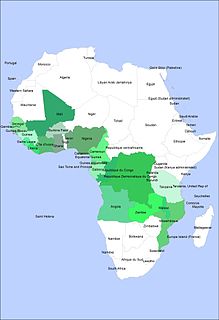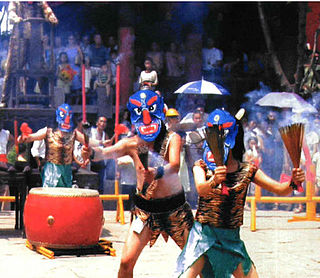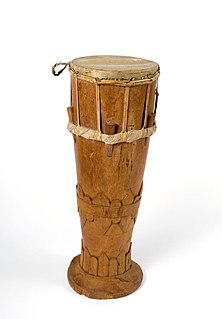
The music of the Cameroon includes diverse traditional and modern musical genres. The best-known contemporary genre is makossa, a popular style that has gained fans across Africa, and its related dance craze bikutsi.

A mask is an object normally worn on the face, typically for protection, disguise, performance, or entertainment. Masks have been used since antiquity for both ceremonial and practical purposes, as well as in the performing arts and for entertainment. They are usually worn on the face, although they may also be positioned for effect elsewhere on the wearer's body.

While lying on the enriched continent of Africa, Equatorial Guinea has proved to be entrenched in ancient rituals and songs. This is especially true for the Fang, a people whose territories begin at the southern edge of Cameroon south of Kribi, Djoum, and Mvangan in the South Province and continue south across the border, including all of Río Muni in Equatorial Guinea, and from there south into Gabon and Congo. The capital island of Bioko has largely been influenced by Spanish customs and traditions during the colonial period, when education and health services were developed in the country.

Equatorial Guinea's culture has been less documented than most African countries, and commercial recordings remain scarce.

The Gẹlẹdẹ spectacle of the Yoruba is a public display by colorful masks which combines art and ritual dance to amuse, educate and inspire worship. Gelede celebrates “Mothers”, a group that includes female ancestors and deities as well as the elderly women of the community, and the power and spiritual capacity these women have in society. Focusing not only on fertility and motherhood but also on correct social behavior within the Yoruba society.
The Ekang are a group of closely related Bantu ethnic groups located in rain forest regions of Cameroon, Republic of the Congo, Equatorial Guinea, Gabon, and São Tomé and Príncipe. Though they separate themselves into several individual clans, they all share a common origin, history and culture.

The Fang people, also known as Fãn or Pahouin, are a Bantu ethnic group found in Equatorial Guinea, northern Gabon, and southern Cameroon. Representing about 85% of the total population of Equatorial Guinea, concentrated in the Río Muni region, the Fang people are its largest ethnic group. The Fang are also the largest ethnic group in Gabon, making up about a quarter of the population. In other countries, in the regions they live, they are one of the most significant and influential ethnic groups notably in Cameroon, where the Fang are part of the Ekang, a tribe that dominates Cameroonian politics with, President Paul Biya belonging to this ethnic group.

The Baga are a West African ethnic group who live in the southern swampy lands of Guinea Atlantic coastline. Traditionally animist through the pre-colonial times, they converted to Islam during the mid-eighteenth century under the influence of Muslim Mandé missionaries. Some continue to practice their traditional rituals.

There are several styles of classical and folk dance in Sri Lanka.

Traditional African masks play an important role in certain traditional African rituals and ceremonies.

Ukrainian folklore is the folk tradition which has developed in Ukraine and among ethnic Ukrainians. The earliest examples of folklore found in Ukraine is the layer of pan-Slavic folklore that dates back to the ancient Slavic mythology of the Eastern Slavs. Gradually, Ukrainians developed a layer of their own distinct folk culture. Folklore has been an important tool in defining and retaining a cultural distinctiveness in Ukraine in the face of strong assimilatory pressures from neighboring lands.

The Balanta are an ethnic group found in Guinea-Bissau, Guinea, Senegal and The Gambia. They are the largest ethnic group of Guinea-Bissau, representing more than one-quarter of the population. Despite their numbers, they have remained outside the colonial and postcolonial state because of their social organisation. The Balanta can be divided into seven clans: Nhacra, Ganja, Naga, Mane, Patch, Sofa and Kentohe. The largest of which are the Balanta Kentohe.
The Gabonese people have forged since the independence of the country, in 1960, their own culture which is neither the traditional culture of the different ethnic groups which compose it, nor modern Western culture. It is a culture in movement, a mixture of diversity and common traits, bringing together the most diverse beliefs and practices.

André Raponda Walker (1871–1968) was a Gabonese author, ethnographer, Catholic priest, and missionary. Walker wrote extensively about Gabonese language and culture.

Nuo opera or Nuo drama is one of China's most popular folk operas. Characterized by its special features such as ferocious masks, unique dresses and adornments, the strange language used in performance, and mysterious scenes, Nuo opera has been selected as one of the non-material cultural legacies of China. The opera is a religious performance intrinsic to the culture of Nuoism, a type of Chinese folk religion. The purpose of Nuo opera is to drive away devils, disease and evil influences, and also to petition for blessings from the gods. Singing and dancing are included in Nuo opera and performers wear costumes and masks.

Benga people are an African ethnic group, members of the Bantu peoples, who are indigenous to Equatorial Guinea and Gabon. Their indigenous language is Benga. They are referred to as Ndowe or Playeros, one of several peoples on the Río Muni coast. Bengas inhabit a small coastal portion of the Cabo de San Juan, suburban enclaves in the coastal municipalities of Mbini and Bata, and the islands of Corisco, Elobey Grande and Elobey Chico.

The Kwele people are a tribal group of eastern Gabon, Republic of the Congo, and Cameroons in Central Africa. They fled the coastal area of West Africa during the 19th century, after their traditional enemies acquired firearms from the slave traders. This altercation is often called the "Poupou" war. The Kwele then settled into lands between the Dja and Ivindo rivers. The Kwele are noted for their ceremonial masks which are collected as art objects.

The tifa, tiwa or tiva is a single-headed goblet drum used throughout the Maluku Islands of Eastern Indonesia, where it is traditionally the "dominant instrument" in Maluku province music. The term tifa has been used outside of the Maluku Islands, including on the island of Java and on the island of New Guinea, in Indonesia's Papua province.
"Bin Sangyeo Nori" refers to performances by the lead vocalist of the funeral songs called "Apsorikkun" and a group of pallbearers or "Sangdukkun". "Apsorikkun" sings the first part of the song while others sing the chorus. At the night before, it happens in order to familiarize themselves with carrying the coffin properly during the morning ceremony. The name originates from three words: "빈" meaning "empty", "상여" meaning "bier" and "놀이" meaning "entertainment.


















